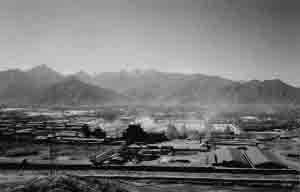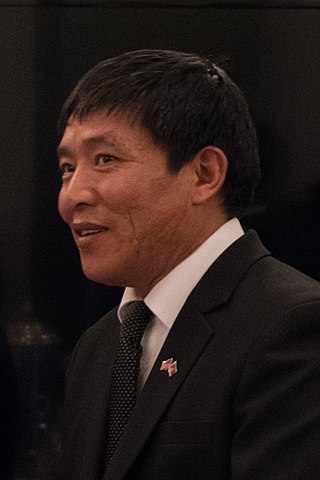Related Research Articles

Laogai, short for laodong gaizao (劳动改造), which means reform through labor, is a criminal justice system involving the use of penal labor and prison farms in the People's Republic of China (PRC). Láogǎi is different from láojiào, or re-education through labor, which was the abolished administrative detention system for people who were not criminals but had committed minor offenses, and was intended to "reform offenders into law-abiding citizens". Persons who were detained in the laojiao were detained in facilities that were separate from those which comprised the general prison system of the laogai. Both systems, however, were based on penal labor.

Re-education through labor, abbreviated laojiao was a system of administrative detention on mainland China. Active from 1957 to 2013, the system was used to detain persons who were accused of committing minor crimes such as petty theft, prostitution, and trafficking of illegal drugs, as well as political dissidents, petitioners, and Falun Gong followers. It was separated from the much larger laogai system of prison labor camps.
Human rights in China are periodically reviewed by the United Nations Human Rights Committee (UNHRC), on which the Chinese Communist Party (CCP), government of the People's Republic of China (PRC) and various foreign governments and human rights organizations have often disagreed. CCP and PRC authorities, their supporters, and other proponents claim that existing policies and enforcement measures are sufficient to guard against human rights abuses. However, other countries and their authorities, international non-governmental organizations (NGOs) including Human Rights in China and Amnesty International, and citizens, lawyers, and dissidents inside the country, state that the authorities in mainland China regularly sanction or organize such abuses.

Harry Wu was a Chinese-American human rights activist. Wu spent 19 years in Chinese labor camps, and he became a resident and citizen of the United States. In 1992, he founded the Laogai Research Foundation.
Pingshi Prison is a prison outside Pingshi Town, Lechang City, Guangdong Province, People's Republic of China connected to the Guangbei Tea Farm (广北茶场).
Panyu Prison is a prison in Huijiang Village (会江村), Dashi Subdistrict, Panyu District, Guangzhou, Guangdong Province, China.

Drapchi Prison, or Lhasa Prison No. 1, is the largest prison in Tibet, China, located in Lhasa. Drapchi is named after its location and was originally a military garrison until it was converted into a prison after the 1959 Tibetan Uprising. It is roughly one mile from the city centre and is the main prison for judicially sentenced prisoners in Tibet. It was the primary place for the detention of political prisoners before 2005 when the newer and modernised Chushur Prison was built. Drapchi also goes by the name Delapuxie prison, which has sometimes been listed as a separate prison online.

The Laogai Research Foundation is a human rights NGO located in Washington, D.C, United States. The foundation's mission is to "gather information on and raise public awareness of the Laogai—China's extensive system of forced-labor prison camps."

The Laogai Museum is a museum in Dupont Circle, Washington, D.C., United States, which showcases human rights in the People's Republic of China, focusing particularly on Láogǎi, the Chinese prison system of "Reform through Labor". The creation of the museum was spearheaded by Harry Wu, a well-known Chinese dissident who himself served 19 years in laogai prisons; it was supported by the Yahoo! Human Rights Fund. It opened to the public on 12 November 2008, and Wu's non-profit research organization calls it the first museum in the United States to directly address the issue of human rights in China. It is now permanently closed.
Ma'anshan Prison is a prison in Ma'anshan, Anhui, China. It was established in 1964. Formerly known as the Ma'anshan Pipe-casting Works. With funding from the City Metallurgy and Building Materials Bureau, the Magang General Company and the Prov. Ma'anshan Trust jointly managed the creation of the Magang Julong Company. In August 2006 began building a new construction that will hold 3000 inmates, 540 People's Police, and will cover an area of 400.46mu. It will be a high-security, medium-sized prison.
Shushan Prison is a prison in Hefei, Anhui, China. It was established in 1955. As in June 2006 it employed 300 police and held 1,500 inmates serving sentences of 10–20 years.
Beijing Municipal No. 1 Prison or No. 1 Detention Center is a prison in eastern Beijing, China, operated by the Beijing Municipal Public Security Bureau. The facility is located in Dougezhuang township, Chaoyang District, in proximity to Beijing Capital International Airport.
The Tibetan Centre for Human Rights and Democracy (TCHRD) is a Tibetan non-governmental nonprofit human rights organization.

Dhondup Wangchen is a Tibetan filmmaker imprisoned by the Chinese government in 2008 on charges related to his documentary Leaving Fear Behind. Made with senior Tibetan monk Jigme Gyatso, the documentary consists of interviews with ordinary Tibetan people discussing the 14th Dalai Lama, the Chinese government, the 2008 Beijing Olympics, and Han Chinese migrants to the region. After smuggling the tapes of the interviews out of Tibet, however, Dhondup Wangchen and Jigme Gyatso were detained during the 2008 Tibetan unrest.
Kate Saunders is an English author, journalist and specialist of Tibet and China. Her articles have been published in newspapers and magazines worldwide including The Times, The Sunday Times, The Washington Post, and The Independent. She has a column in The Sunday Guardian.

Lukar Jam Atsok or commonly Lukar Jam, born 1972, in Tsolho Dragkartri district, in Amdo, Tibet. He is a Tibetan refugee and political activist that ran for Prime Minister of the Tibetan Government-in-Exile in Dharamshala, India in 2016. A former Chinese political prisoner, Lukar Jam went on to become President of the non-profit Gu-Chu-Sum, dedicated to the welfare of Tibetan political prisoners. He has worked as a civil servant with the Tibetan Government-in-Exile and currently lives in the Tibetan enclave of McLeod Ganj, high above Dharamsala, India in the western foothills of the Himalayas.
References
- Laogai Handbook 2007-2008 (PDF) (in Chinese and English). Washington, D.C.: Laogai Research Foundation. October 2008. pp. 487–490. ISBN 978-1-931550-25-3 . Retrieved 24 May 2017.